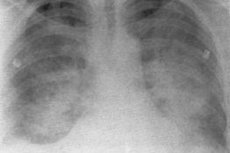Syndrome of compaction of lung tissue
Last reviewed: 29.11.2021

All iLive content is medically reviewed or fact checked to ensure as much factual accuracy as possible.
We have strict sourcing guidelines and only link to reputable media sites, academic research institutions and, whenever possible, medically peer reviewed studies. Note that the numbers in parentheses ([1], [2], etc.) are clickable links to these studies.
If you feel that any of our content is inaccurate, out-of-date, or otherwise questionable, please select it and press Ctrl + Enter.

Pulmonary compaction syndrome is one of the most pronounced manifestations of pulmonary diseases. Its essence consists in a significant reduction or complete disappearance of the airiness of the lung tissue in a more or less common area (segment, proportion, simultaneously several parts). Foci of compaction differ in localization (lower regions, apex of the lungs, middle lobe, etc.), which also has a differential diagnostic value; specially allocate subpleural localization of the center of densification with the involvement of visceral and friendly parietal pleura sheets, which is accompanied by the addition of signs of pleural syndrome. The development of compaction can occur quite quickly ( acute pneumonia, lung infarction ) or gradually ( swelling, atelectasis ).
There are a number of types of pulmonary densification: infiltrate (pneumonic focus) with the release of inclined to a caseous disintegration of the tuberculous infiltrate; lung infarction due to thromboembolism or local vascular thrombosis; Obturation (segmental or lobar) and compression atelectasis (collapse, collapse of the lung) and hypoventilation; a variant of atelectasis is the hypoventilation of the middle lobe due to obturation of the median-laryngeal bronchus (bronchopulmonary lymph nodes, fibrous tissue), which, as is well known, does not adequately ventilate the share, the middle lobe syndrome; swelling of the lung; congestive heart failure.
Subjective manifestations of pulmonary densification syndrome are different depending on the nature of the compaction and are considered when describing the relevant diseases.
A common objective sign of the developing decrease in airiness corresponding to the tightening of the pulmonary tissue is the asymmetry of the chest, revealed during examination and palpation.
Regardless of the nature of this syndrome, with large foci of compaction and their superficial location, one can detect swelling and lagging when breathing this part of the chest (and only with large obturation atelectasis it is possible to draw it), voice tremor is strengthened. Percussion is determined by blunting (or absolute stupidity) in the area of compaction, and in the presence of infiltration (pneumonia), in the initial stage and in the resorption period, when the alveoli are partially free of exudate, and the draining bronchi retain full patency (and therefore contain air), blunting It is combined with a tampanic shade of percussion sound. The same blunt-tampanic hue with percussion is noted in the initial stage of atelectasis development, when there is still air in the alveoli and a message with the resulting bronchus is maintained. In the future, when the air is completely dispersed, a blunt percussion sound appears. A blunt percussion sound is also noted above the tumor node.
Auscultatory in the infiltration zone in the initial and final stages of inflammation, when there are few exudates in the alveoli and they break down when the air enters, weakened vesicular breathing and crepitation are heard. In the midst of pneumonia due to the filling of the alveoli with exudate, vesicular breathing disappears and is replaced by a bronchial respiration. The same auscultatory pattern is observed with a lung infarction. At any atelectasis in the initial stage (hypoventilation), when there is still a small ventilation of the alveoli in the fall zone, vesicular breathing is weakened. Then, after resorption of air in the case of compression atelectasis (compression of the lung from the outside with fluid or gas of the pleural cavity, tumor, with a high diaphragm standing), bronchial breathing is heard: the bronchus remaining in the air carries bronchial respiration, which extends to the periphery by a compressed compressed area of the lung. With obturation atelectasis (a decrease in the lumen of the bronchus leading to the endobronchial tumor, a foreign body, compression from the outside) in the stage of complete blockage of the bronchus over the airless zone, no breathing will be heard. Breathing will also not be heard over the tumor site. Bronchophony with all kinds of seals repeats the patterns revealed by the definition of voice jitter.
With auscultation above the plepletally located infiltrate and tumor, as well as with lung infarction, the pleural friction noise is determined.
Since often with various variants of densification involved in the bronchial process, it is possible to detect varicolored wet rales. Of particular diagnostic importance is listening to small bubbly sonorous wheezing, indicative of the presence around the small bronchi of the infiltration zone, which enhances the sound vibrations arising in the bronchi.
With heart failure, the airyness of the pulmonary tissue decreases, primarily in the lower parts of the lungs on both sides, which is associated with stagnation of blood in a small circle of circulation. This is accompanied by a shortening of the percussion sound, sometimes with a tympanic tinge, a lower excursion of the lower edge of the lungs, a weakening of the vesicular breathing, the appearance of moist finely bubbling rales, sometimes crepitus.

